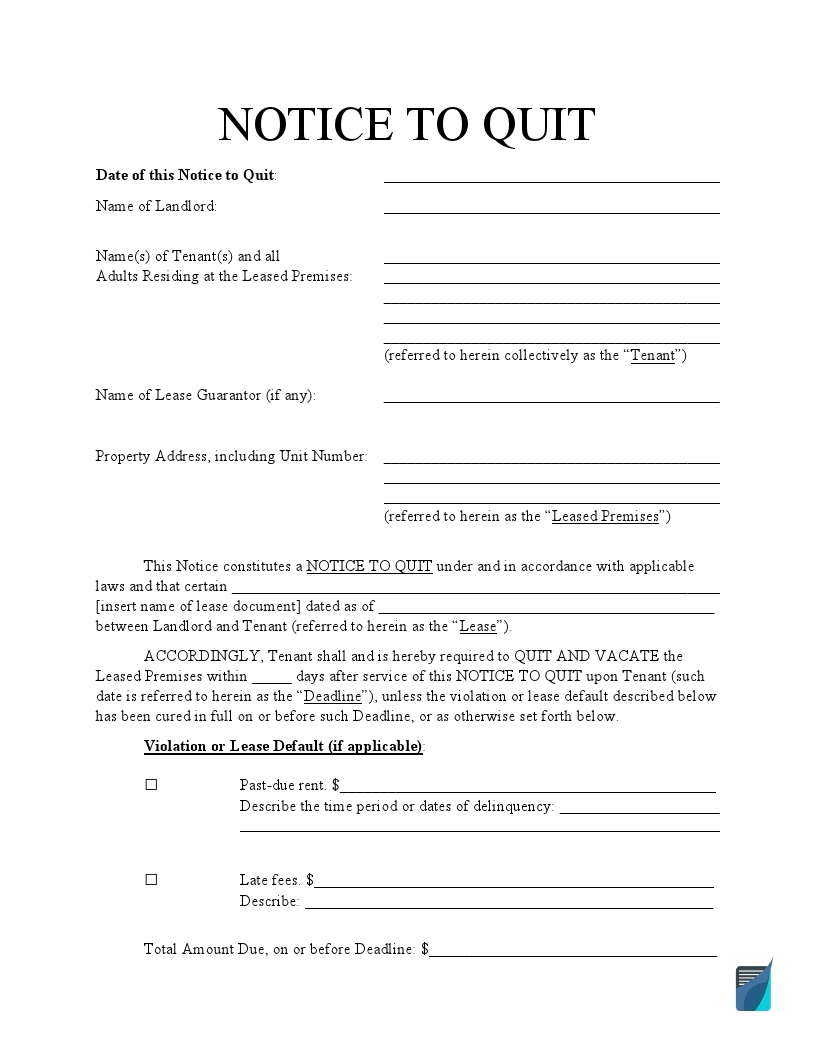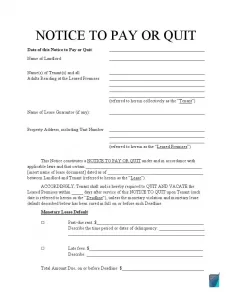5-Day Eviction Notice to Pay or Quit
A landlord uses a 5-day notice form to evict a non-compliant tenant from the leased premises. The 5 days are given to the tenant to address the problem mentioned in the eviction notice. If the problem is not fixed within 5 days, the landlord can evict the tenant after a certain period of time. The eviction notice is most commonly sent when a tenant fails to pay rent. It can also be used for other violations of the lease agreements, such as keeping authorized pets, sub-letting, or not following building rules.
The following states require a five-day notice to quit be given for violations of the rental terms: Alaska, Arizona, Delaware, Hawaii, Illinois, Louisiana, Nevada, Oklahoma, Rhode Island, South Carolina, Virginia, and Wisconsin.

Build Your Document
Answer a few simple questions to make your document in minutes
Save and Print
Save progress and finish on any device, download and print anytime
Sign and Use
Your valid, lawyer-approved document is ready
5-Day Eviction Notice to Pay or Quit Form Details
| Document Name | 5-Day Eviction Notice to Pay or Quit Form |
| Other Names | 5-Day Notice to Vacate, Five-Day Eviction Notice |
| Avg. Time to Fill Out | 11 minutes |
| # of Fillable Fields | 47 |
| Available Formats | Adobe PDF |

Filling Out the 5-Day Template
You can fill out FormsPal’s easy to use and understand this eviction notice template by following these simple steps:
Notice Period
Mention “5” in all the blanks where “_ Day Notice” is written.
Notice Date
Enter the date of the eviction notice. Five days will be calculated from the day following this date and will exclude weekends and public holidays.
Party Details
Mention full details of the landlord and tenant as mentioned in the lease agreement. Enter the details of the lease guarantor, if applicable.
Address
Mention the full address of the leased property.
Lease Date
Mention the date of the lease agreement. If you cannot remember it, make sure to check the original document.
Select and Describe the Reason
Select the reason for sending the 5-day notice to quit.
- Illegal Activities: Select the first option if the reason is illegal activities at the leased premises. Mention other related details, including the type of illegal activity taking place and how you became aware of it.
- Breach of Rental Agreement: If the eviction notice to quit is being sent for breach of the rental terms by the tenant, select the second option. Refer to the violated terms of the agreement in brief. For example, if the reason is subletting, mention the clause that prohibits subletting by the tenant.
- Rental Dues: If the eviction notice to quit is for non-payment of rent, select the third option, enter the total amount due, and mention the due date.
Select the Follow-up Action or Cure
Based on the reasons for sending the notice to quit, select the corrective action that has to taken by the tenant:
- If the notice to vacate is for illegal activities, choose the first option and mention the number of days when the tenant should leave the property.
- If the notice to quit form is for breach of the agreement’s legal terms, select the second option and mention how and by when the corrective action should be taken.
- If the notice is for rental dues, select the third option and mention the total amount due and the time period within which the dues must be paid.
Mention the Notice Serving Details
Mention all the details relating to the service of the notice quit form.
- Specify the landlord’s name.
- If the form is being sent through an authorized representative, mention his or her details.
- Mention the details of all individuals to whom the notice to quit form is being sent.
- Select the delivery mode (certified mail is recommended), enter the state and county, and get it notarized.
What to Do After the Notice is Served?
If the tenant makes full payment, it must be accepted by the landlord, and eviction cannot happen. If the tenant makes a partial payment, the landlord decides to accept or decline. If accepted, it will constitute partial compliance with the notice, and eviction cannot be done. If no payment is made, legal action to evict can be taken.
For breach of the rental agreement, if the tenant fully addresses the issues within five days, then eviction will not be possible. However, if partial compliance is made by the tenant, it is for the landlord to decide to accept or not. If no compliance is made, court action can be taken.
To take legal action to evict the tenant, an “unlawful detainer” must be filed with the court. However, it is a lengthy and complex process; therefore, efforts must be made to settle the matter with the tenant before proceeding.